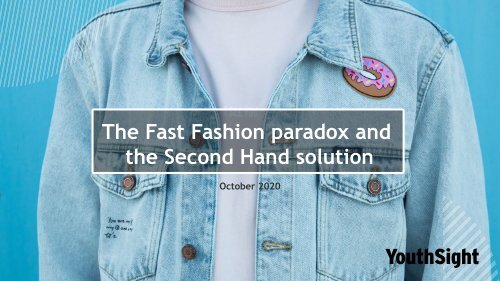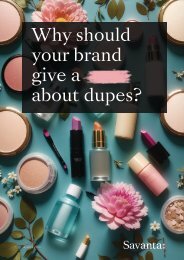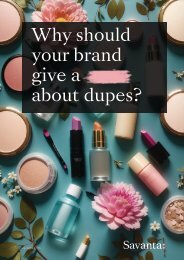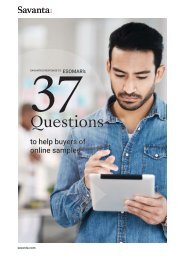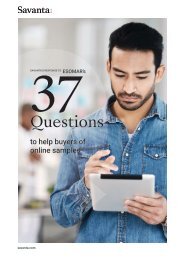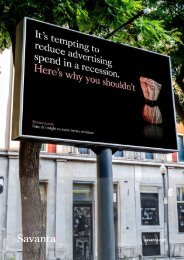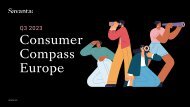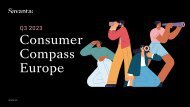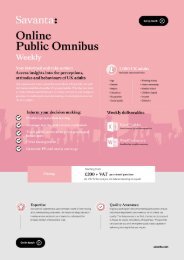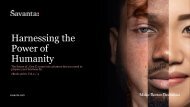The Fast Fashion Paradox and the Second Hand Solution eBook
Fast fashion and second hand shopping share a common audience in Gen Z. While it’s no secret that Gen Z are trying to save the world from climate change, they are still living their lives in pictures on social media, using fast fashion as a status symbol. We see second hand shopping as a sustainable alternative to fast fashion, providing Gen Z with unique and affordable pieces.
Fast fashion and second hand shopping share a common audience in Gen Z. While it’s no secret that Gen Z are trying to save the world from climate change, they are still living their lives in pictures on social media, using fast fashion as a status symbol. We see second hand shopping as a sustainable alternative to fast fashion, providing Gen Z with unique and affordable pieces.
You also want an ePaper? Increase the reach of your titles
YUMPU automatically turns print PDFs into web optimized ePapers that Google loves.
<strong>The</strong> <strong>Fast</strong> <strong>Fashion</strong> paradox <strong>and</strong><br />
<strong>the</strong> <strong>Second</strong> H<strong>and</strong> solution<br />
October 2020
As an insight agency, our goal is to help our clients<br />
grow within <strong>the</strong> youth market by better underst<strong>and</strong>ing<br />
Gen Z <strong>and</strong> Millennials.<br />
We typically help our clients navigate youth culture to<br />
remain relevant, achieve cut-through <strong>and</strong> grow within<br />
<strong>the</strong> youth market.
Our Take<br />
<strong>Fast</strong> fashion <strong>and</strong> second h<strong>and</strong> shopping share a common audience in<br />
Gen Z. While it’s no secret that Gen Z are trying to save <strong>the</strong> world<br />
from climate change, <strong>the</strong>y are still living <strong>the</strong>ir lives in pictures on<br />
social media, using fast fashion as a status symbol. We see second<br />
h<strong>and</strong> shopping as a sustainable alternative to fast fashion,<br />
providing Gen Z with unique <strong>and</strong> affordable pieces.<br />
This ebook seeks to explore Gen Z’s multi-faceted attitudes <strong>and</strong><br />
values, by using <strong>the</strong>ir clo<strong>the</strong>s shopping habits to shine a light on<br />
<strong>the</strong>ir paradoxical behaviours.<br />
Many of <strong>the</strong> data points shown in <strong>the</strong> ebook have been taken from<br />
our State of <strong>the</strong> Youth Nation insight tracker. Our tracker helps<br />
br<strong>and</strong>s <strong>and</strong> organisations stay on top of <strong>the</strong> evolving attitudes <strong>and</strong><br />
behaviours of young people.<br />
Get in touch to see how State of <strong>the</strong> Youth Nation can help you win<br />
over <strong>the</strong> next generation – research@youthsight.com
STATE OF THE YOUTH NATION<br />
helping you make better youth market decisions<br />
Tracking <strong>the</strong> decision-making of 16-24s since 2015
<strong>Fashion</strong> is disposable for Gen Z…<br />
23%<br />
Of Gen Z buy an item <strong>and</strong> wear it<br />
once before chucking it out 1<br />
Almost<br />
1 in 10<br />
Buy more than ten items a month<br />
from online fast fashion retailers 1<br />
Source: Vice x Snapchat (1)
Gen Z live <strong>the</strong>ir lives in<br />
pictures; <strong>and</strong> fast fashion<br />
allows <strong>the</strong>m to do so<br />
Gen Z have a do it for <strong>the</strong> ‘gram mentality. <strong>The</strong>y want to look like<br />
<strong>the</strong>y are living <strong>the</strong>ir best lives on social media – it’s a status<br />
symbol.<br />
<strong>Fashion</strong> is a tool used by Gen Z to establish social currency.<br />
This has fuelled “wear it once” culture. Once you’ve posted an<br />
outfit on social media it can’t be posted again because it’s now<br />
too old – <strong>the</strong> likes <strong>and</strong> comments stop rolling in.<br />
<strong>Fast</strong> fashion enables Gen Z to<br />
switch up <strong>the</strong>ir style regularly,<br />
cheaply <strong>and</strong> quickly.<br />
If you search #OOTD on Instagram, which st<strong>and</strong>s for<br />
outfit of <strong>the</strong> day, it results in 312 million posts.<br />
For young people, fashion is disposable.<br />
6
It’s not surprising <strong>the</strong>n, that<br />
fast fashion has boomed in<br />
recent years<br />
2 in 5 have purchased<br />
something on a fashion<br />
website in <strong>the</strong> last month 2<br />
Clothing production in <strong>the</strong> UK<br />
has doubled since 2000 2<br />
Online retailer’s such as Boohoo made<br />
over £1 billion in revenue last year 3<br />
7<br />
Source: Vice (2), Financial Times (3)
And br<strong>and</strong>s are making <strong>the</strong>ir clo<strong>the</strong>s more<br />
readily available to Gen Z in a few ways…<br />
2. Flexibility of payment<br />
1. Slashing prices<br />
Take Missguided’s infamous £1<br />
bikini for example - it was a<br />
loss-making promotional item<br />
designed to draw Gen Z in.<br />
Financial services like Klarna<br />
<strong>and</strong> Clearpay are available on<br />
fast fashion sites, giving cashstrapped<br />
Gen Z <strong>the</strong> option to<br />
buy more <strong>and</strong> pay back over a<br />
period of time or pay later.<br />
3. Convenience fashion<br />
With many fast fashion retailers<br />
offering next day delivery from<br />
as little as £5.99 a year, Gen Z<br />
can have almost instant access<br />
to fashion. This is perfect for <strong>the</strong><br />
zero-effort generation.<br />
8
But fast fashion goes against<br />
Gen Z’s core values<br />
Despite <strong>the</strong> popularity of fast fashion, Gen Z are conscious of<br />
its ethical impact. Backlash against <strong>the</strong> fast fashion industry is<br />
growing as it clashes with Gen Z’s high concern for <strong>the</strong><br />
environment <strong>and</strong> <strong>the</strong> threat of climate change.<br />
Gen Z’s most important political issues (Top 5) 4<br />
Climate change<br />
41%<br />
Racism<br />
Coronavirus<br />
Healthcare<br />
Economic inequality<br />
Source: State of <strong>the</strong> Youth Nation (4), Refinery29 (5)<br />
Simply doubling <strong>the</strong> length of time we keep<br />
our clo<strong>the</strong>s would cut emissions by 44% 5<br />
9
Gen Z are increasingly holding br<strong>and</strong>s<br />
accountable to <strong>the</strong>ir ethics<br />
Many Gen Zs want to buy from companies that align with<br />
<strong>the</strong>ir ethical beliefs. We see from our data that it is<br />
females in particular, who would prefer to purchase from<br />
ethical companies despite also buying from fast fashion<br />
companies.<br />
I prefer to only buy products from companies that<br />
I believe are acting ethically<br />
FEMALES ONLY 6<br />
37%<br />
51%<br />
Over<br />
half<br />
Of under 24s want to buy<br />
from labels that are kinder to<br />
<strong>the</strong> environment 7<br />
2019 2020<br />
10<br />
Sources: State of <strong>the</strong> Youth Nation (6), <strong>The</strong> Guardian (7)
Although Gen Z know <strong>the</strong>y have<br />
options…<br />
54%<br />
of Gen Z feel bad about buying<br />
fast fashion clo<strong>the</strong>s 8<br />
58%<br />
of Gen Z say that money isn’t <strong>the</strong> issue<br />
– <strong>the</strong>y’re happy to pay more for<br />
ethically sourced products 9<br />
…<strong>the</strong>y still buy fast fashion<br />
Sources: Vice x Snapchat (8), State of <strong>the</strong> Youth Nation (9)
So, how to square <strong>the</strong> circle?
Sustainable <strong>Solution</strong>s<br />
13
Many fast fashion <strong>and</strong> high street br<strong>and</strong>s are<br />
offering responsible options<br />
2. Recycling incentives<br />
1. Sustainable lines<br />
<strong>The</strong>se give Gen Z <strong>the</strong> option to<br />
shop responsibly yet still use<br />
<strong>the</strong> same platforms/shops that<br />
<strong>the</strong>y like <strong>and</strong> are used to - like<br />
ASOS <strong>and</strong> Zara for example.<br />
Shops like H&M <strong>and</strong> Primark<br />
have rolled out schemes to get<br />
customers to bring in nolonger-worn<br />
clo<strong>the</strong>s for <strong>the</strong>m<br />
to recycle in return for<br />
vouchers.<br />
3. Sustainable first<br />
New br<strong>and</strong>s are making<br />
sustainability a commitment to<br />
all <strong>the</strong>ir clo<strong>the</strong>s, providing<br />
ethically sourced <strong>and</strong><br />
recyclable products, such as Gen<br />
Z athleisure br<strong>and</strong> TALA.<br />
14
However, <strong>the</strong> ‘ethical’ attempts of some<br />
br<strong>and</strong>s have backfired with Gen Z<br />
Greenwashing is when a company sells itself or its<br />
products as good for <strong>the</strong> environment <strong>and</strong> eco-friendly,<br />
however once you scratch beneath <strong>the</strong> surface it<br />
becomes quite clear that this is marketing spin.<br />
A third of Gen Z say <strong>the</strong>ir trust in<br />
companies is at an all time low 10<br />
This has increased by 6% since 2018<br />
Gen Z’s scepticism of companies has fed into ‘Cancel Culture’ which is increasingly holding br<strong>and</strong>s<br />
accountable, in fact 83% would boycott a br<strong>and</strong> if <strong>the</strong>y didn’t agree with <strong>the</strong>ir values 11. So, where does<br />
this leave Gen Z <strong>and</strong> <strong>the</strong>ir shopping habits?<br />
Sources: State of <strong>the</strong> Youth Nation (10), Voxburner (11)<br />
15
<strong>Second</strong>-h<strong>and</strong> is a sustainable solution that is<br />
affordable <strong>and</strong> provides Gen Z with unique pieces<br />
Sustainable fashion lines are less affordable<br />
than traditional fast fashion, <strong>and</strong> may just<br />
push Gen Z back towards fast fashion.<br />
<strong>Second</strong>-h<strong>and</strong> shopping provides Gen Z with a<br />
middle ground between trying to be more<br />
sustainable yet not breaking <strong>the</strong> bank.<br />
12<br />
It also still allows <strong>the</strong>m to experiment with<br />
<strong>the</strong>ir style, having rare, vintage or one-of-akind<br />
items.<br />
16<br />
Sources: LSE (12)
In fact, young people have already begun<br />
to drive <strong>the</strong> solution forward<br />
<strong>The</strong>y are <strong>the</strong> driving force of <strong>the</strong> growth of second-h<strong>and</strong><br />
shopping, adopting second-h<strong>and</strong> apparel 2.5x faster than<br />
o<strong>the</strong>r age groups. 13<br />
Given <strong>the</strong> choice, where would you prefer to shop?<br />
<strong>Second</strong>-h<strong>and</strong>/charity shops 14<br />
10%<br />
16%<br />
8%<br />
of Gen Z currently buy most of<br />
<strong>the</strong>ir belongings from<br />
charity/second-h<strong>and</strong> shops 14<br />
4%<br />
6%<br />
2015 2018 2019 2020<br />
17<br />
Sources: Forbes (13), State of <strong>the</strong> Youth Nation (14)
Thanks to innovative platforms, second-h<strong>and</strong> clothing has<br />
been reinvented<br />
Gone are <strong>the</strong> days of trawling dusty charity shop for clo<strong>the</strong>s. Apps <strong>and</strong> online e-tailers like Depop,<br />
Vestiaire <strong>and</strong> Vinted have overhauled <strong>the</strong> second-h<strong>and</strong> image, where cool clo<strong>the</strong>s are easily accessible.<br />
With over 15 million users worldwide, Depop has been<br />
able to win over Gen Z by offering a place to buy <strong>and</strong> sell<br />
that looks just like Instagram. It’s not just a marketplace,<br />
it’s a community of creatives, with many sellers able to<br />
make it <strong>the</strong>ir Depop shops <strong>the</strong>ir full time job.<br />
Vestiaire Collective has established a platform for <strong>the</strong><br />
second-h<strong>and</strong> luxury market - a win-win for Gen Z, having<br />
access to designer labels within a sustainable cycle<br />
90% of Depop’s active<br />
users are under 26 16<br />
Vestiaire Collective’s<br />
sales grew by 144% from<br />
July 2019 to July 2020 15<br />
18<br />
Sources: Glossy (15), <strong>The</strong> Independent (16)
What does this tell us about Gen Z?<br />
Gen Z are paradoxical – <strong>the</strong>y have<br />
conflicting wants <strong>and</strong> desires. In <strong>the</strong><br />
short term, <strong>the</strong>y want easily accessible<br />
unique pieces to wear <strong>and</strong> gain social<br />
status. Yet in <strong>the</strong> longer term, <strong>the</strong>y<br />
want to help tackle climate change<br />
For this generation, everything is<br />
about easy access. Although<br />
accessibility to second h<strong>and</strong> items<br />
has improved using tech, e.g. Depop,<br />
buying a whole outfit is not fast. <strong>Fast</strong><br />
fashion platforms on <strong>the</strong> o<strong>the</strong>r h<strong>and</strong><br />
are effortless.<br />
19
What does this tell us about Gen Z?<br />
<strong>Second</strong> h<strong>and</strong> shopping delivers Gen<br />
Z’s desire for br<strong>and</strong>s <strong>and</strong> unique stuff.<br />
<strong>The</strong> apps are usually peer-to-peer,<br />
which makes <strong>the</strong>m relevant <strong>and</strong><br />
cool. Yet to really make a change,<br />
Gen Z need to reject <strong>the</strong> wear-it-once<br />
culture which buying second h<strong>and</strong><br />
does not address directly.<br />
Gen Z don’t follow <strong>the</strong> crowd - <strong>the</strong><br />
popularity of second h<strong>and</strong> shopping<br />
<strong>and</strong> its unique pieces tells us that<br />
<strong>the</strong>y don’t want to look <strong>the</strong> same as<br />
everyone else. <strong>The</strong>y want to find <strong>the</strong>ir<br />
own sense of style while at <strong>the</strong> same<br />
time not st<strong>and</strong>ing out too much.<br />
20
“Our subscription to State of <strong>the</strong><br />
Youth Nation is a valuable resource<br />
<strong>and</strong> helps us underst<strong>and</strong> young<br />
people around <strong>the</strong> country with<br />
data <strong>and</strong> actionable insight. <strong>The</strong><br />
insight workshops are also very<br />
useful, enabling us to focus on <strong>the</strong><br />
topics that are most<br />
strategically important.”<br />
Strategic Research & Programmes<br />
Manager, <strong>The</strong> FA<br />
State of <strong>the</strong> Youth Nation membership<br />
gives you access to:<br />
Latest Gen Z insights<br />
• Our tracking data illuminates emerging trends<br />
• Our Culture Lists keep you plugged into youth culture<br />
• Our fortnightly Spotlight reports uncover <strong>the</strong> latest datadriven<br />
trends.<br />
Regular webinars<br />
• Let us tell you what we think – our webinars always<br />
include best in class marketing examples<br />
• Tune in ei<strong>the</strong>r live or on-dem<strong>and</strong><br />
Insight Workshops<br />
• Challenge us to address your youth-focused objectives<br />
• Our interactive workshops inspire change<br />
• Leave this workshop with an action plan to improve your<br />
youth marketing strategy<br />
21
THANK YOU!<br />
To find out more about how State of <strong>the</strong> Youth Nation could help<br />
answer your business questions, get in touch at:<br />
research@youthsight.com<br />
22


